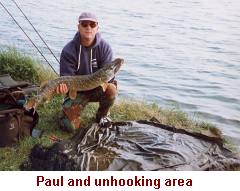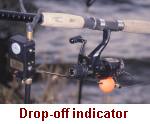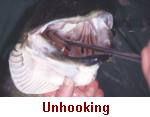In the wrong hands, there is no doubt in my mind that a pike will cause as much or even more damage to itself than any pain and damage it may inflict on its captor. A damaged hand will heal, a damaged pike, however, may not! In any event, with care you will never sustain any serious injury and the worst that I ever suffer is the occasional scratch from the gill rakers. 
In spite of its size and impressive set of teeth, the pike is one of our most fragile species; like many species, poor handling can prove fatal, but old Esox will not cope with being caught on a regular basis and may sulk and even die on some occasions if not cared for correctly or nursed properly after capture. Unhooking large and even small pike can be complicated for the young novice and for the older seasoned angler who wishes to target pike as a change from other species. Providing that you are prepared to put the safety of the fish first by adhering to the following guidelines, you should be able to enjoy one of the most fascinating and varied forms of our sport and confidently land, unhook and return your fish time and time again. I will start by covering just a few areas and tackle presentations to ensure the safety of the fish prior to landing. These may appear to be fairly standard for the more experienced. This article, however, is aimed at the newcomer, although I think it is reasonable to assume that it will also provide a refresher for those that may not have been piking for some time. I would recommend that you use 15lb mainline and 20lb wire trace. My personal favourite monos are Berkley Big Game and more recently Sufix Synergy in the higher breaking strains. They have never let me down, but by all means try other brands. Likewise, wire trace material such as Drennan Seven Strand, Calibre Wonder Wire (25lb) and Middy Tech Core are all very reliable. Hooks should be strong and I recommend semi-barbless hooks from manufacturers such as Partridge, Terry Eustace or Drennan in size 8 or 6 for large baits. The barbed hook on the treble is for mounting your baits and using semi-barbless hooks makes for easier unhooking of the pike. Don’t worry about losing fish on barbless hooks, it rarely happens with pike. Use a minimum trace length of say 20 inches. I have caught fish that have wrapped the wire trace around their snouts with the swivel and mainline dangerously close to the teeth. Using a shorter trace may result in the pike biting through your mainline and you do not want to lose a fish in this situation as its death will be inevitable. You can either crimp or twist your wire traces to your hooks and swivels. Most manufacturers give guidelines on the packaging and both are effective when tied correctly. If you are concerned about tying your own traces, you can buy them ready-made by Drennan or Fox, but it is cheaper and much more satisfying to practice and make your own. Swivels should be strong and I recommend Berkley McMahon in size 10. Hooks should be around three inches apart, although it pays to tie traces with the hooks at varying distances apart to suit various sizes of bait. I always prefer to have one treble in the flank or middle of a deadbait as the pike will initially pick up your offering side on before turning the bait head first to swallow. Do not under any circumstances place a treble at the top and bottom of the bait as you most certainly risk a deep-hooked pike. To fish effectively you will need rods and reels that can cope with big fish and cast heavy baits up to around 6oz. The ideal rod size is 12ft with a minimum test curve of 2.5lbs, although you could get away with a slightly lighter test curve when fishing at close range. Reels should be able to accommodate around 150yds or more of 15lb line. Make sure that your unhooking area is well organised. You will need a large unhooking mat. Remember, pike are long and slender and not big and round like carp, so if you already have an unhooking mat it may need to be changed. Place the mat on flat ground, as pike have a tendency to slide off. Your unhooking tools or implements should comprise a set of 8 and 10 inch steel forceps, wire cutters or trace blades, long-nose pliers and snips. All of these must be close at hand to minimise delays in unhooking. The wire cutters are to quickly snip off flying trebles that may get caught in the net whilst landing. If you do not do this quickly, the pike may use the treble to twist the net around itself, ripping a hole in the net, or worse still ripping the remaining treble out of its mouth causing serious damage. Long-nose pliers are useful for removing stubborn hooks and for blunting the barb on the third treble should this get caught up in the sinewy tissue inside the pike’s mouth around the scissors. Bite indication is the next important aspect and I always recommend a heavy drop back indicator, which should ideally be used with a sensitive front-mounted electronic bite alarm. Alternatively, use one of the many rear-mounted electronic drop-off alarms, such as the ET backbiter, Ghetto Blaster or Fox Micron P or Micron PS. Always use a drop-back indicator when using free-lined and running leger rigs, as occasionally a running leger set-up can get caught in the mainline, in effect preventing a run. Line will not pull line out of the line clip or off your free spool/baitrunner, as expected. You can increase the weight of the drop-back indicator by adding putty or lead. Indicators are available with sliding weights so that you can adjust the indicator to suit the circumstances. In addition to having everything you need close to hand it is important that you do not wander from your rods. This is so much more important with pike than any other species in order to avoid delays in striking and to prevent deep-hooking. Stay put and be ready to zip up immediately if nature calls from the bush behind you, or better still, reel in and use the toilet. Now that you are comfortable and sitting next to your rods it is important to gauge the right time to strike when you get your first bite or run. As soon as the fish pulls line out of your clip or your indicator drops back, lift up your rod immediately and feel for your fish through thumb and forefinger. If the fish is running, take up all slack and lean into your fish. It will not be necessary to strike your fish hard, more a case of ensuring a good hook hold by winding down firmly or drawing the hooks into the fish. With a drop-back bite, again take up any slack and feel the fish on the end. Again, wind down to the fish as above. Do not waste time in reacting to bites or runs from pike. Because you are organised, your landing net, which should be strong and have at least 40 inch arms, will be at your side ready to land your pike. I always try to locate the trebles as the pike nears the bank. At this stage you will know if there are any flying trebles and you can plan accordingly in your mind your actions before placing the fish on the mat. Ensure the head of the pike is close to the spreader block before lifting the net over the fish. Do not under any circumstances attempt to hand land your fish until you are an experienced piker. Providing that there are no flying trebles, it is always advisable to leave the pike in the net for a minute or so to recover before lifting out of the water and onto the unhooking mat. With the pike now safely on the mat, make sure that your rod is out of the way and preferably back on the rests with the bale-arm open. Kneel with the fish between your legs. The pike should be on its side with the head pointing away from you. Having already located the trebles, carefully slide your fingers under the pikes gill cover towards the jaws where there will be a firm piece of skin to hold under the lower jaw. Hold securely with thumb and forefinger and gently pull open the lower jaw. The mouth should now be wide open and you should be able to see the trebles. At this point the pike may struggle so keep a firm hold of the jaw. Quickly clamp the shank of the treble that is furthest into the mouth with your forceps, twist out the hook and pull to one side. Remove the remaining hook and place the rig well out of the way of the net and unhooking area. With the fish unhooked, quickly weigh the fish in a suitable sling. A big pike may slip out of a small sling so use the appropriate size sling for the job. Always weigh and photograph your fish close to the mat to avoid accidents. If photos are required, be prepared and don’t waste time digging around in your tackle bag. If necessary, place your fish in a purpose made pike tube for a few minutes whilst you prepare your camera. After photos, carefully take your pike back to the water in the weigh sling and gently submerge the fish, supporting it at all times. There is no more a satisfying site than watching your prize predator swimming off into the depths where it belongs. Hopefully I have covered all angles of pike safety for the beginner. I will supplement this article at a later stage with Part 2, which will give details of how to hand-land and unhook your fish without removing it from the water, which minimises damage even further. But at this stage I wish you happy and safe piking. |
Welcome!Log into your account













 If the pike is hooked close to the entrance of the gut, you may find it easier unhooking through the gills, but this takes a bit of practice and do not risk damaging the gill rakers if you are not confident. If you find that a barbed hook has found its way into the mouth tissue, take extra care. If you are able, blunt the barb with long-nose pliers. If this is not possible, you may have to cut the barb off with snips.
If the pike is hooked close to the entrance of the gut, you may find it easier unhooking through the gills, but this takes a bit of practice and do not risk damaging the gill rakers if you are not confident. If you find that a barbed hook has found its way into the mouth tissue, take extra care. If you are able, blunt the barb with long-nose pliers. If this is not possible, you may have to cut the barb off with snips.  It the fish goes belly-up for some reason, sit with it whilst it rights itself. This can occasionally take time. Do not allow the fish to swim off until it is ready. It will start to kick its tail when ready to go. If in doubt, place the fish in the pike tube and stake it out in sufficiently deep water until it has recovered fully.
It the fish goes belly-up for some reason, sit with it whilst it rights itself. This can occasionally take time. Do not allow the fish to swim off until it is ready. It will start to kick its tail when ready to go. If in doubt, place the fish in the pike tube and stake it out in sufficiently deep water until it has recovered fully. 